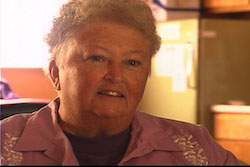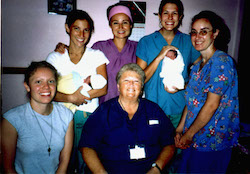It would be difficult to say where Sister Angela Murdaugh, MSN, RN, CNM, FACNM, has made a more profound difference: advancing the profession of nurse midwives through years of advocacy or improving the health and well-being of thousands of the nation’s poorest women and their children who have benefited from the Holy Family Birth Center she opened in Welasco, Texas. There is no wrong answer.
Thirty years ago, the Catholic order of the Franciscan Sisters of Mary decided to send Sister Angela to the Texas Rio Grande Valley, one of the poorest, hottest regions in the United States. Sister Angela was finishing her master’s degree in maternal nursing and nurse midwifery at Columbia University and passed the board exam to become credentialed as a certified nurse midwife (CNM). By 1972 when she reached Raymondville, a small town near the southern tip of Texas, she nwas ready to take on her new responsibilities as a nurse at Su Clínica, a federal migrant health center.
 She quickly discovered the difficulties local women faced in obtaining health care. “Most of the women labor as seasonal farm-workers, making between $1 and $3 per gunnysack filled with picked onions, cucumbers, turnips—whatever is in season,” she explains. “They have no health insurance or car, and there is no public transportation. Consequently they become isolated, staying in their colonias.” At the time the local women—who typically marry young and have numerous children—had another reason to worry. “The local clinics did not offer maternity care. If a woman wanted a hospital delivery, she had to find a ride, travel 25 miles on rough, rural two-lane highways stopping through small towns to get to the Harlingen hospital [the only hospital with an obstetrician in the region].” This was unacceptable to 32-year-old Sister Angela. “These women desperately needed a birthing center,” she said, “and I promised myself that it would happen.”
She quickly discovered the difficulties local women faced in obtaining health care. “Most of the women labor as seasonal farm-workers, making between $1 and $3 per gunnysack filled with picked onions, cucumbers, turnips—whatever is in season,” she explains. “They have no health insurance or car, and there is no public transportation. Consequently they become isolated, staying in their colonias.” At the time the local women—who typically marry young and have numerous children—had another reason to worry. “The local clinics did not offer maternity care. If a woman wanted a hospital delivery, she had to find a ride, travel 25 miles on rough, rural two-lane highways stopping through small towns to get to the Harlingen hospital [the only hospital with an obstetrician in the region].” This was unacceptable to 32-year-old Sister Angela. “These women desperately needed a birthing center,” she said, “and I promised myself that it would happen.”
Gaining Ground for CNMs
In the meantime, Sister Angela faced some formidable obstacles to establishing the first nurse midwifery clinic in the state. “From the moment I set foot in Texas, I knew I was going to have a horrific fight on my hands,” she recalls today. The Texas Board of Medical Examiners had declared that when CNMs were delivering babies, they were practicing medicine. Sr. Angela was heavily involved in the fight against this assertion, and an opinion was requested from the Texas Attorney General’s office, which issued an opinion (H1293) in 1978 that clearly stated that CNMs were not practicing medicine by delivering babies, thus clearly defining the legal base for nurse midwives to practice in Texas.
The next obstacle was the issue of direct reimbursement. “As luck would have it, the sole physician on the Texas Medicaid Advisory Committee was an obstetrician who frequently declared, ‘over my dead body will nurse midwives ever receive Medicaid reimbursement for delivering babies in Texas,’” she said. Six years into her fight, Sister Angela was approached by an attorney who offered to represent the clients of her birth center in a class-action lawsuit that would require Medicaid to pay for nurse midwifery. “After just one letter from [the attorney], the doctor lost his steam,” said Sister Angela. “The taste of victory was sweet in 1989 when I received the first Medicaid provider number issued for a CNM in the State of Texas.” Today, all 50 states allow direct Medicaid reimbursement to CNMs.
In 1986, Sister Angela served on the Texas Department of Health advisory committee that wrote the original Texas Birth Center Rules and Regulations, and assisted with their revision 10 years later. She is currently helping to update them. She helped write the National Association of Childbearing Center’s “Standards for Birth Centers” and serves as site visitor to birth centers seeking accreditation based on those standards. Her efforts have not gone unnoticed. A frequent television and radio guest as well as a keynote and commencement speaker, in 1990 she was awarded the most prestigious honor that a CMA can receive, the Hattie Hemschemeyer Award for outstanding contributions to midwifery and maternal and child health. On September 10, 2002, she was inducted into the Texas Women’s Hall of Fame, sharing the honor with former recipients the late former Congresswoman Barbara Jordan, former Governor Ann Richards, former First Lady Barbara Bush and astronaut Sally Ride.
Breaking Ground for the Women of Texas
In 1980, Sister Angela began looking for medical and financial support. Funding came through private grants, contributions from the local diocese, and the sponsorship of three Catholic orders. Help often came from unexpected directions. “An electrical contractor passionately wanted this birth center to open,” she recalls, “He’d call his friends to help, so that construction was free or at a huge discount.”
 In 1983, on four acres of former cucumber fields, Sr. Angela opened the Holy Family Birth Center, with one sister to manage the office, two CNM sisters, and two RN sisters. News of the clinic spread by word of mouth and since then, the complex has expanded significantly. Today its bright yellow buildings are home to a clinic, a classroom, a chapel, six birthing suites, and a residence for staff, fellows, students, and visitor. Seven RNs, four CNMs, two fellows, and two volunteers deliver services. Over 20 years, more than 5,000 babies have been delivered at the center, which is accredited by the Commission for the Accreditation of Birth Centers. With the U.S. infant mortality rate at 7.0 deaths per 1,000 births (1999 data),1 the birth center rate is only 1.3 per 1000; 0.7 per 1000 if lethal anomalies are excluded. Her victory for nurse midwifery in Texas has had a ripple effect nationwide. Today there are over 160 freestanding childbearing centers located throughout the United States.
In 1983, on four acres of former cucumber fields, Sr. Angela opened the Holy Family Birth Center, with one sister to manage the office, two CNM sisters, and two RN sisters. News of the clinic spread by word of mouth and since then, the complex has expanded significantly. Today its bright yellow buildings are home to a clinic, a classroom, a chapel, six birthing suites, and a residence for staff, fellows, students, and visitor. Seven RNs, four CNMs, two fellows, and two volunteers deliver services. Over 20 years, more than 5,000 babies have been delivered at the center, which is accredited by the Commission for the Accreditation of Birth Centers. With the U.S. infant mortality rate at 7.0 deaths per 1,000 births (1999 data),1 the birth center rate is only 1.3 per 1000; 0.7 per 1000 if lethal anomalies are excluded. Her victory for nurse midwifery in Texas has had a ripple effect nationwide. Today there are over 160 freestanding childbearing centers located throughout the United States.
“At our center, if the patients don’t have Medicaid, they are happy to work off their bill with in-kind services such as doing laundry, mowing, trimming bushes, cleaning, or driving,” said Sister Angela. “We’re a family-friendly place. If the volunteers have babies they are breast-feeding or young children, they’re welcomed at the center with open arms.”
Birth center volunteers and clinical fellows routinely describe their work as a life-changing experience. “I like the fact that I’m crossing all the lines—doing public health, childbirth education, health teaching, clinic work, labor and delivery, antepartum, well-baby clinics, home visits,” explains Shaanti Abbruzzese, a University of California at San Francisco nurse midwifery graduate who recently completed a fellowship. “I’ll never look at maternal care the same again.”
To learn more, visit www.holyfamilybirthcenter.com.
REFERENCE
1. National Center for Health Statistics. New CDC Report Shows Decline in Infant Mortality Rate in 1999 Analyzes Patterns of Infant Mortality. Centers for Disease Control and Prevention. 2002. http://www.cdc.gov/nchs/releases/02facts/99infant.htm.

 Austin, Texas
Austin, Texas